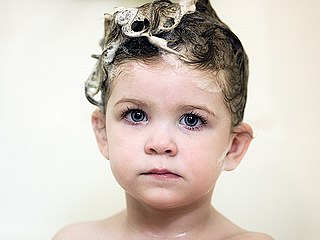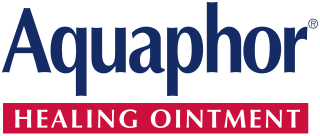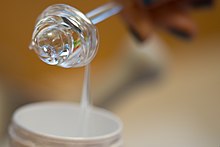
Pantothenic acid (vitamin B5) is a B vitamin and an essential nutrient. All animals need pantothenic acid in order to synthesize coenzyme A (CoA), which is essential for cellular energy production and for the synthesis and degradation of proteins, carbohydrates, and fats.

Cosmetics are composed of mixtures of chemical compounds derived from either natural sources or synthetically created ones. Cosmetics have various purposes. Those designed for personal care and skin care can be used to cleanse or protect the body and skin. Cosmetics designed to enhance or alter one's appearance (makeup) can be used to conceal blemishes, enhance one's natural features, add color to a person's face, or change the appearance of the face entirely to resemble a different person, creature or object. Cosmetics can also be designed to add fragrance to the body.

Petroleum jelly, petrolatum, white petrolatum, soft paraffin, or multi-hydrocarbon, CAS number 8009-03-8, is a semi-solid mixture of hydrocarbons, originally promoted as a topical ointment for its healing properties. Vaseline has been an American brand of petroleum jelly since 1870.
A humectant is a hygroscopic (water-absorbing) substance used to keep things moist. They are used in many products, including food, cosmetics, medicines and pesticides. When used as a food additive, a humectant has the effect of keeping moisture in the food. Humectants are sometimes used as a component of antistatic coatings for plastics.

Hair conditioner is a hair care cosmetic product used to improve the feel, texture, appearance and manageability of hair. Its main purpose is to reduce friction between strands of hair to allow smoother brushing or combing, which might otherwise cause damage to the scalp. Various other benefits are often advertised, such as hair repair, strengthening, or a reduction in split ends.

A moisturizer, or emollient, is a cosmetic preparation used for protecting, moisturizing, and lubricating the skin. These functions are normally performed by sebum produced by healthy skin. The word "emollient" is derived from the Latin verb mollire, to soften.

Hair care or haircare is an overall term for hygiene and cosmetology involving the hair which grows from the human scalp, and to a lesser extent facial, pubic and other body hair. Hair care routines differ according to an individual's culture and the physical characteristics of one's hair. Hair may be colored, trimmed, shaved, plucked or otherwise removed with treatments such as waxing, sugaring and threading. Hair care services are offered in salons, barbershops and day spas, and products are available commercially for home use. Laser hair removal and electrolysis are also available, though these are provided by licensed professionals in medical offices or speciality spas.
Selsun Blue is an over-the-counter brand of dandruff shampoo now owned by Sanofi. First made by Abbott Laboratories, the brand was bought by Chattem in 2002. Chattem was acquired by Sanofi in 2010, although in some markets, it is sold by Rohto Pharmaceutical instead. Selsun Blue has been marketed as a more effective alternative to brand leader Head & Shoulders due to its superior performance in randomized trials.

Lotion is a low-viscosity topical preparation intended for application to the skin. By contrast, creams and gels have higher viscosity, typically due to lower water content. Lotions are applied to external skin with bare hands, a brush, a clean cloth, or cotton wool.

Skin care or skincare is a range of practices that support skin integrity, enhance its appearance, and relieve skin conditions. They can include nutrition, avoidance of excessive sun exposure, and appropriate use of emollients. Practices that enhance appearance include the use of cosmetics, botulinum, exfoliation, fillers, laser resurfacing, microdermabrasion, peels, retinol therapy, and ultrasonic skin treatment. Skin care is a routine daily procedure in many settings, such as skin that is either too dry or too moist, and prevention of dermatitis and prevention of skin injuries.
Personal care products are consumer products which are applied on various external parts of the body such as skin, hair, nails, lips, external genital and anal areas, as well as teeth and mucous membrane of the oral cavity, in order to make them clean, protect them from harmful germs and keep them in good condition. They promote personal hygiene and overall health, well-being and appearance of those body parts. Toiletries form a narrower category of personal care products which are used for basic hygiene and cleanliness as a part of a daily routine. Cosmetic products, in contrast, are used for personal grooming and beautification. Pharmaceutical products are not considered personal care products.

Shampoo is a hair care product, typically in the form of a viscous liquid, that is used for cleaning hair. Less commonly, shampoo is available in solid bar format. Shampoo is used by applying it to wet hair, massaging the product into the scalp, and then rinsing it out. Some users may follow a shampooing with the use of hair conditioner.
A barrier cream is a topical formulation used in industrial applications and as a cosmetic to place a physical barrier between the skin and contaminants that may irritate the skin. There are many other terms for creams designed to protect skin from harmful substances, including skin protective creams, pre-work creams, antisolvent gels, protective ointments, and shielding lotions. Three classes of barrier creams are used: water repellent creams, water-soluble creams, and creams designed for special applications. Barrier creams may contain substances such as zinc oxide, talc or kaolin to layer over the skin. For hand care they are designed to protect against the harm from detergents and other irritants.

Facial care is a comprehensive process that involves a variety of products and routines aimed at maintaining the health, appearance, and radiance of the skin. The effectiveness of a facial care regimen depends on various factors such as skin type, sensitivity, age, hyperpigmentation, and acne. To achieve the best results, it is crucial to choose products that are suitable for your specific skin type and address any particular skin concerns you may have. There are many different forms of skin care treatments and practices, each offering unique benefits for the skin. Some popular forms of facial care include facial steaming, facial massage, and the use of masks. These treatments can help to cleanse, hydrate, and rejuvenate the skin, leaving it looking and feeling refreshed.

Egg oil, also known as egg yolk oil or ovum oil, is derived from the yolk of chicken eggs consisting mainly of triglycerides with traces of lecithin, cholesterol, biotin, xanthophylls lutein and zeaxanthin, and immunoglobulins. It is free of egg proteins and hence may be used safely by people who are allergic to eggs, for topical applications such as hair and skin care. The product has several historical references in Unani (Greek) medicine for hair care. Traditional Chinese medicine uses egg oil for burns, eczema, dermatitis, mouth ulcers, skin ulcers, chapped nipples, tinea capitis, ringworm, nasal vestibulitis, frostbite, and hemorrhoids.
Silk amino acid (SAAs) also known as Sericin is a natural water-soluble glycoprotein extracted from raw silk. It is used as an additive in skin and hair care products due to its high levels of serine which has excellent moisture preservation characteristics. As a water-based additive it is used to provide a protective barrier and silky feel to lotions, soaps, personal lubricants, hair and skincare products. Silk amino acids are produced by hydrolyzing silk proteins into smaller peptide chains, typically 18 to 19 amino acids in length. Silk amino acids have a lower molecular weight than silk protein powders and are moisturizing to skin and hair.

Aquaphor is a brand of over-the-counter (OTC) skin care ointments manufactured by Beiersdorf Inc., an affiliate of Beiersdorf AG. Aquaphor is offered in four product ranges: There are two skin protectant ointments. Aquaphor Original Ointment, used as a compounding agent and Aquaphor Advanced Therapy Healing Ointment, sold in mass retail outlets. The other product ranges include: Aquaphor Lip Repair and Lip Repair + Protect SPF 30, and Aquaphor Baby.

Beard oil is a cosmetic product that is used to nourish both the skin under the beard and the beard itself in order to keep it "soft, shiny, and smooth". Beard oil mimics the natural oils produced by skin, such as sebum, and is composed mainly of carrier oils and essential oils.
Phytantriol is an aliphatic alcohol used in cosmetic products and as a food additive. At room temperature it is a viscous liquid that is colourless to light yellow and with a sweetish odour.
Horse ointment, known as horse oil and horse fat, is a topical formulation derived from subcutaneous fat of horses. Due to its thickness and viscosity, horse ointment is intended for topical use on human skin and mucous membranes to moisturize and increase the restoration of damaged skin. Horse ointment was traditionally prepared and used in ancient China for the treatment of qi deficiency, hemorrhoids, burns, and xeroderma. Due to the amount of fatty acids in horse ointment, which is similar to that of human skin fat, it can penetrate through the surface of skin. Nowadays, it is commonly applied to skin for the purpose of soothing redness and irritation. It is considered a natural skincare product with low risks of sensitization and irritation and is safe for people of all ages, including infants and seniors.















